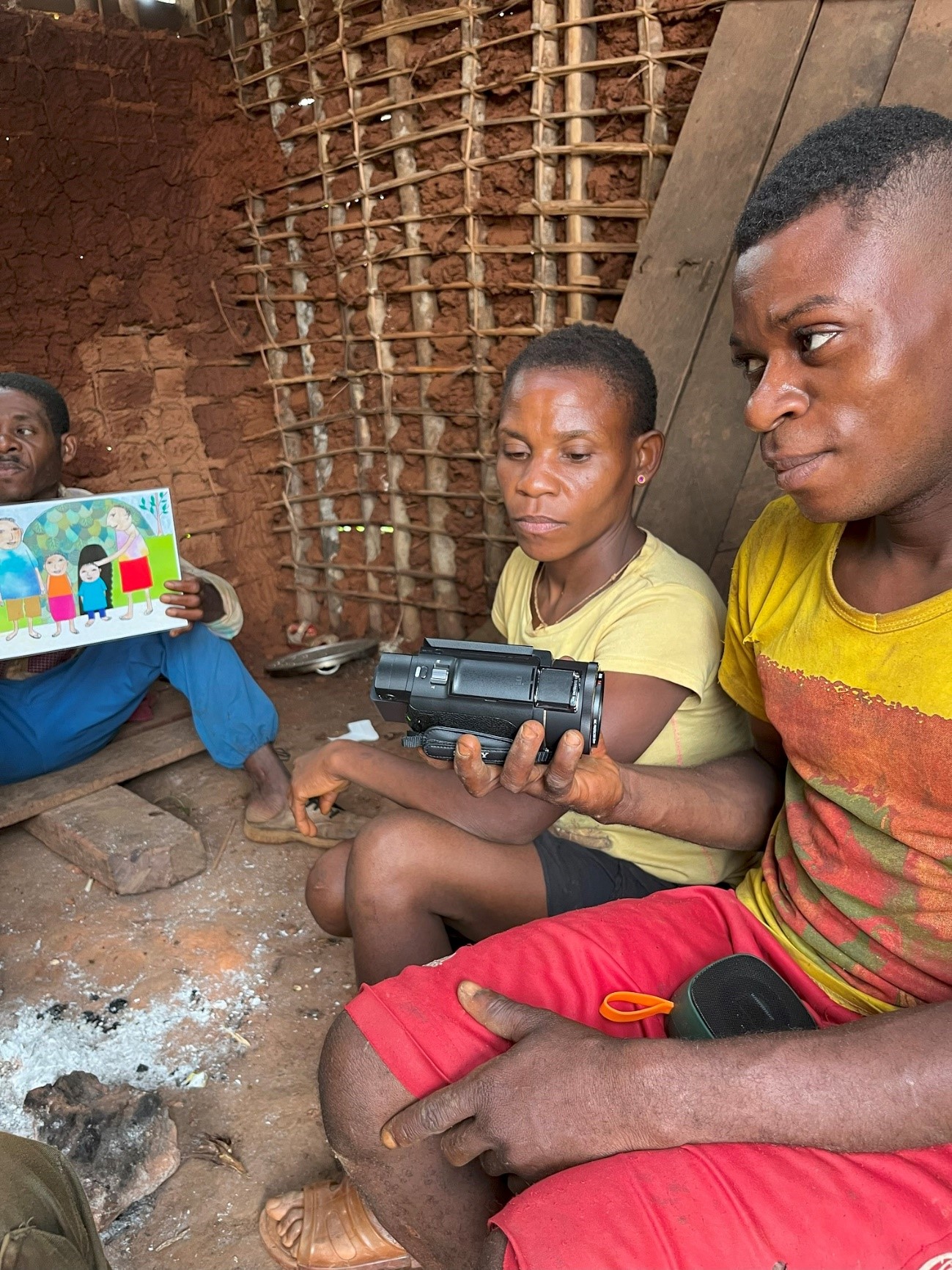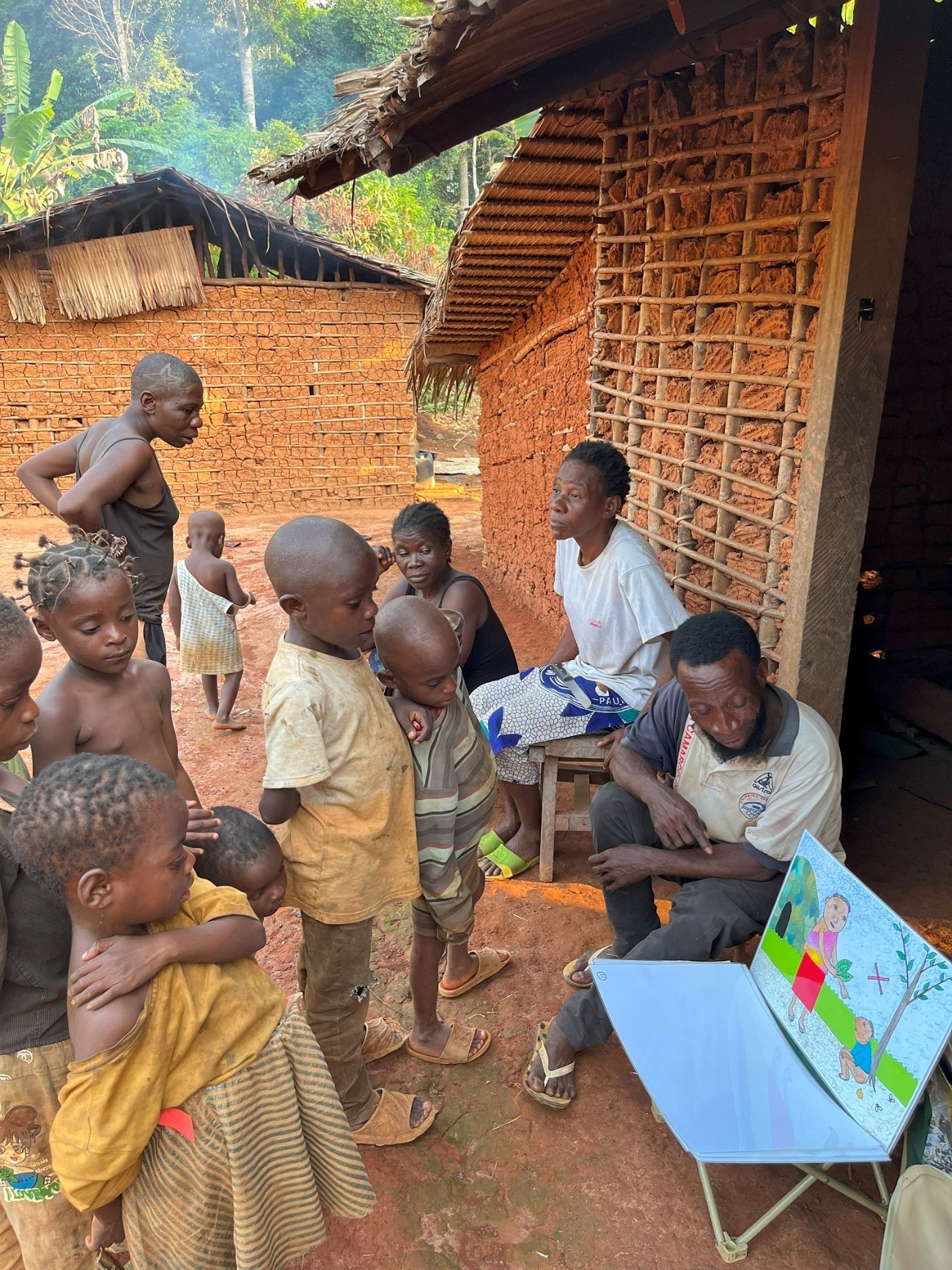Report on the Dispatch to Cameroon: Action Research on Sanitation Improvement Using Picture Storytelling
Kyoto University
The Center for African Area Studies, Specially Appointed Research Fellow
Koji Hayashi

From February 17 to March 15, 2024, I visited to the Republic of Cameroon to conduct fieldwork with the Baka Pygmies (hereafter referred to as “Baka”) in and around Lomié in the forest region of the Eastern Province. Here, I report on the process and conditions of my action research using a picture-story show as part of the project “Ecological Future making of Childrearing in Contact Zones between Hunter-Gatherers and Agro-pastoralists in Africa”.
The theme of the storytelling is related to “Water, Hygiene and Sanitation (WASH)” in the living environment of the Baka with an enlightening aim. Prior to visit to Cameroon, I drew a rough story and rough drawings, and Ms. Emi Nakayama, the project technical assistant, was entrusted with the corresponding drawings. While making requests regarding the atmosphere and details of the drawings to Ms. Nakayama, I made color copies and laminated 15 sheets of the completed picture storyboard, and brought some A4-size and some A3-size sheets to Cameroon. The stories were translated into English and French for each picture storyboard, and before my trip, Dr. Towa O. W. Kamgaing, a Cameroonian researcher affiliated with ASAFAS, helped us translate the stories into everyday Cameroonian French. In Yaoundé, the capital of Cameroon, Mr. Simon-Pierre Etoga (a representative of the Association Tam-Tam Mobile (NGO), who is familiar with the sanitation-related situation in Cameroon) made some additional corrections to Kamgaing’s version of the text.
In Lomié, my research site in the Eastern Province, I was supported by Mr. Aleka Raymond, a Baka member of ASTRADHE (an NGO that provides educational support to Baka), translated the French version into Baka. Afterwards, I filmed his reading the text and had some Bakas livings in the suburbs of Lomié watch it, discussing the terminology used in the Baka’s language and whether the content of the text was understood, and making revisions as necessary. Since there were only a limited number of people in the Lomié area who can read the Baka text accurately, I tried several demonstrations of the storytelling by having Mr. Aleka read the revised Baka text again. And I filmed it again, having some Bakas watch it several times, and then communicating it to the audience along with the picture storytelling. After that, I tried to demonstrate the picture-story show several times with the video reading. Finally, I also tried several demonstrations, in which I conveyed the information drawn in the pictures to the audience (include children) from the speaker’s own point of view and interpretation, without relying on the text, and filmed these demonstrations.
The first original story was written by me based on my experience of conducting fieldwork in the Baka society in Cameroon for a long time, while consolidating information on WASH based on the same purpose. However, for example, the word for “bai-kin(バイ菌)” in Japanese and the way it is expressed as a picture would be understood by audience and listener until it was actually demonstrated in the field. In addition, the literal translation of “Bai-kin” into English and French would be terms/germs/germes, respectively, but Dr. Kamgaing pointed out that in Cameroon, replacing the word with microbes (= pathogenic bacteria, germs, microorganisms) would be the easiest way to convey the message, including to children. Furthermore, since no word could be found in the Baka dictionary (Brisson 2010) that corresponded to the Baka word, several candidate words were solicited, and after reviewing them, the word was adopted.

Although the analysis of the filmed images will be done in near future, but will focus primarily on the following topics; (1) Analyzing the interaction between the speaker and the audience (children and adults surrounding), (2) How the speaker, who understands the story (content) of the picture-story show to some extent, communicates it in his/her own words through the demonstration of the show, and (3) How the audience reacts to the performance.
After the fieldwork in Lomié, I met with Mr. Benant Messe (head of the Association Okani, local NGO in Bertoua, the capital of the Eastern Province) who commented with great interest on the process and effectiveness of this project. He pointed out some of the depictions that he thought were difficult to convey to children in Baka, and suggested that in the future, we should give the children art materials and ask them to draw freely on the theme (WASH) and create a separate picture story show using these materials. This idea is expected to raise children’s awareness of WASH, and could be further developed as action research to observe children’s involvement with each other and with the adults around them when drawing.



It should also be added that the following unexpected events occurred. Mr. Mintiet Christoph, a Nzimé farmer who has been a friend of mine for several years in the suburbs of Lomié, has an exceptional eye for observation and drawing skills, and enjoys drawing with a ballpoint pen. During my stay in Lomie this time, I introduced the picture-story show project to him and asked him if he would draw pictures based on his own interpretation and sensibility, giving him the original drawings and French stories drawn by Ms. Nakayama. A few days later, he painted a very unique picture titled “UN HABITAT SALUBRE POUR LES COMMUNAUTES INDIGENES-Une eau potable-Une vie saine” (Healthy living environment for indigenous communities – drinking water and healthy living). While the general story and idea of the painting is based on the elements drawn by the reporter and Ms. Nakayama, the depiction of the living environment and the composition of the painting are original, and can be considered as materials that provide insight into the cultural background of the agrarian perspective living in this region. As a future development of the action research, I would like to analyze the paintings by Mr. Nakayama, Mr. Christoph, and the children of Baka by comparing them.
P.S. I would like to express my gratitude to the people I have mentioned above, as well as to the organizations and people involved in this project for their cooperation.
